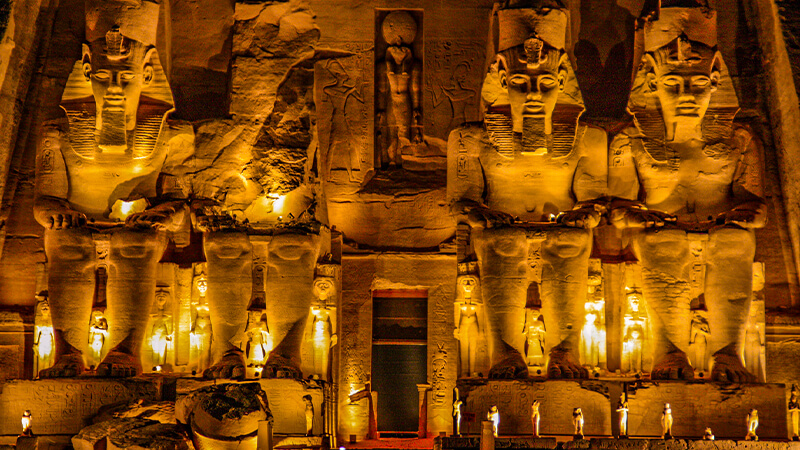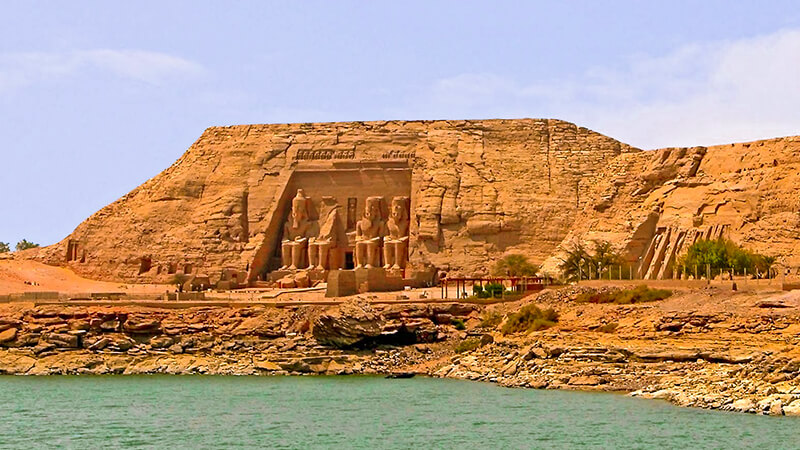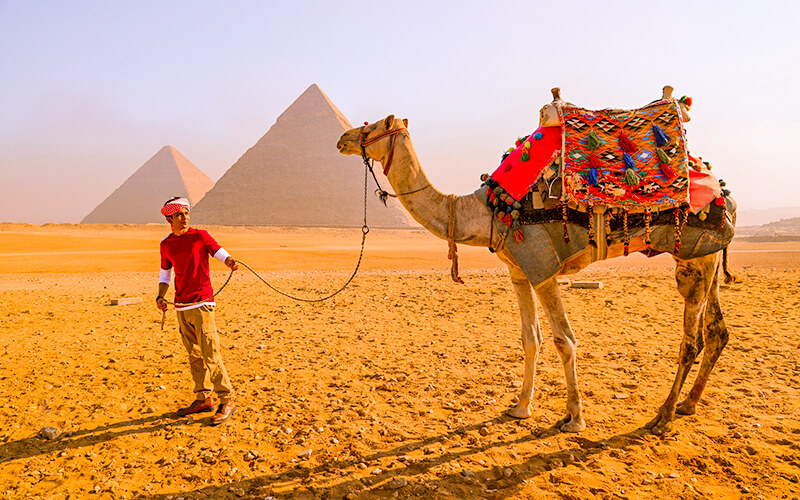Abu Simbel Temple
The sun aligning on the face of King Ramses’ sitting statue to honor his birthday one day and his coronation the next is a rare occurrence that occurs twice a year. here, you’ll find all FAQs you need to know about the Abu Simbel Temple.
If you’re looking to spend a fantastic vacation in Egypt check out our Egypt Excursions with our qualified Egyptologist with the best Egypt travel guide in Egypt.
Where is the Abu Simbel Temple located?

Abu Simbel Temple in Aswan
Abu Simbel is a small town near Aswan in Upper Egypt, and it is on the western side of Lake Nasser, not too far from the border with Sudan. You can find the Temples of Abu Simbel right here in this area.
The reason behind the construction of the temples in Abu Simbel. The King and his Queen Nefertari merited a lasting tribute, so the twin temples were created to honor them and the victory they earned at the Battle of Kadesh.
Who discovered the Temples of Abu Simbel?

Abu Simbel Temple at night
Swiss explorer Johann Ludwig Burckhardt discovered the temples on March 22, 1813, after they had been covered in sand for many years. However, Giovanni Battista Belzoni, an Italian, didn’t start investigating them until 1817. Since the sand was ultimately removed in 1909, these twin temples, which had been buried under sand for centuries, have become among southern Egypt’s most famous sights.
How would the Abu Simbel Temples appear?

Lake view of the temples of Abu Simbel
There are two places where people can pray. The first one, called the “Great Temple,” is for Ramesses II, and the second, called the “Small Temple,” is for Ramesses’ queen, Nefertari. The front of this temple is decorated with four 20-meter-tall statues of Pharaoh Ramses II sitting on his throne. On either side of each sculpture are smaller versions of his mother and his favorite wife, Nefertiti. A few of his children rest between their legs.
Great Temple
The Great Temple of Abu Simbel was built over nearly twenty years. The Egyptian gods Amun, Ra-Horakhty, and Ptah, as well as the Great King Ramesses, were honored at the Temple of Ramses II.
Most people agree that, of all the temples built during the reign of Ramesses II, this one is the biggest and most impressive, making it one of Egypt’s most beautiful sights. Four vast statues of Ramesses II sitting on a throne stand on either side of the entrances to the Great Temple. Every one of these statues is 20 meters tall. The victory of Ramses II at the Battle of Kades is shown in detailed hieroglyphs right in the middle of the main temple. The vast temple has several halls dedicated to Ramses and his family. Except for two days a year, the last room in the sanctum sanctorum is permanently dark. This wasn’t done by accident; it took a lot of knowledge in many different fields, such as science, math, architecture, and astronomy.
Small Temple
The goddess Hathor is honored at the second temple, which is called the Small Temple. Even though this one is much smaller than the first, it was built in honor of Nefertari, Ramses’ favorite wife. The Temple of Queen Nefertari and King Amenhotep III is another name for the Temple of Hathor and Nefertari.
What happened to one of the statues at Abu Simbel?

Abu Simbel Temple in Aswan
These statues were originally 22 in number, one for each of Upper Egypt’s provinces. The varying stone quality in these mountains and the significant earthquake that rocked Egypt in 27 BC explain these differences. The second one from the left is the statue’s head, which most likely came off decades ago. The head’s descent broke the terrace of the temple. The northern deck appeared to be in a reasonable condition other than that. Additionally destroyed were a temple honoring the deity of falcons and a few statues of pharaohs. Furthermore, this is the only portion of the structure constructed without chiseling into the rock. In the holy section of the temple, a granite block functioned as a platform for the god Amon’s sacred boat. This room was constructed with great care and knowledge.
Sun alignment at Abu Simbel Temple:

Sun aligns with the Ramses II Temple at Abu Simbel twice a year
Twice a year, the sun aligns with the Ramses II Temple in Abu Simbel; The sun shines into the deepest reaches of the more esteemed temple because of its ecliptic position.
It illuminates a statue of Ramses and the presiding deities of the temple. The room would be illuminated by natural light on his birthday, October 22, and the anniversary of his accession to the throne, February 22, thanks to the ancient temple’s constructors. The four sculptures in the sanctuary and the hallway leading to the temple are illuminated by the sun as it rises on these two days.
The first three statues depict Egyptian King Ramses II, the sun deity Ra, and the god Ammon (the king of the gods). Ramses was grouped with the gods because he, like the other pharaohs, believed himself to be divine. Due to the presence of Ptah, the deity of darkness, the first three are still in its shadow in the fourth statue. More than 3,200 years have passed since this statue was last viewed in broad daylight.
An official UNESCO-designated World Heritage Site. After the Giza Pyramids, the Abu Simbel Temples are Egypt’s second most famous structure. They are located south of Aswan on the coast of Lake Nasser. The enormous rock-cut temples known as the Temple of Ramses II or Ramesses II marked the southern boundary of the Egyptian Empire at the height of the New Kingdom when Nubia was at its greatest. They were built under Ramesses II, frequently recognized as Egypt’s greatest ruler.
Check our article about How to choose the best Nile Cruise in Egypt and don’t miss to book one of the Egypt Nile Cruise with us and check our Egypt Vacation Packages.



